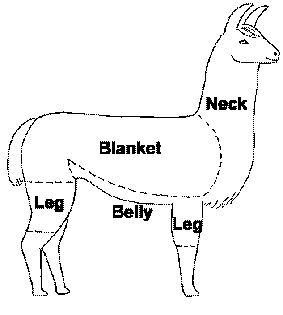The following article by Paige McGrath was written in 1996. However, as I re-read it this morning from a perspective of 15 years raising llamas I have to admit that when I first read the article I did not appreciate the wisdom and experience that Paige had wrapped up in this short set of guidelines. Thank you Paige.
About the Author
Paige McGrath has bred llamas at Lower Sherwood Farm in Charlottesville, VA since 1986. She is the publisher of Llama Life II, and contributes to the lama show world by providing the Virginia Classic Llama and Alpaca Show each spring. Email Paige or visit her website for more info!
Originally published in Llama Life II, Fall 1996 – Issue #39
We relinquish copyright protection on the following for the purpose of allowing those, who do not have their own written standards and who sell to those who have little understanding of camelid care, a comparatively concise outline that may be reproduced and distributed or given to new owners. The byline may be removed and additions, modifications and alterations to suit individual circumstances may be made.
1. Don’t buy babies younger than 4 or 5 months
Unweaned crias (baby llamas) are not suitable pets. If you have inadvertently obtained one, bottle feed it 20 percent of its weight daily with plain homogenized Vitamin D milk (reinforced with nutrients if it doesn’t gain daily) and don’t cuddle it. Offer it a coarse sweet feed and free choice quality hay at an early age. It will start to nibble when it is ready. Naturally raised crias, not normally weaned until six months, should gain a half to a full pound daily. Provide it with another animal for company – preferably a llama – but keep physical human contact to a minimum. An adult llama bonded to a human from near-birth without proper herd socialization can be a danger when the animal treats the human as another llama. Seek information from knowledgeable reputable breeders or veterinarians. A reputable breeder will not sell you a cria under four or five months of age.
2. Llamas left haltered are in peril
Because many owners don’t train their animals to haltering, or provide a catch pen or stall for doing so, they leave the halters on all the time. This results in abscesses, ulcers, unsightly calluses….and, if the halter is caught on something, a broken neck. And because haltering has not been mastered, some owners leave the SAME halter on a growing animal. Some have been found with the flesh growing around the noseband or with malformation of the nasal passages.
Continue reading

